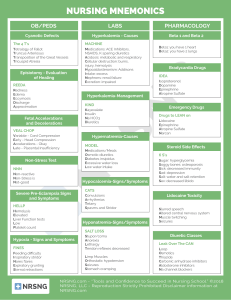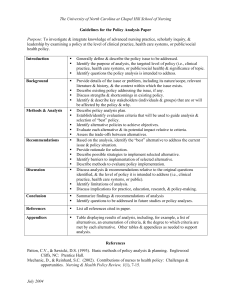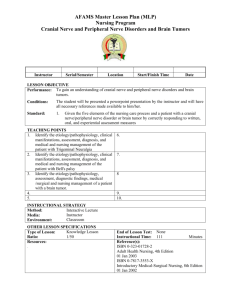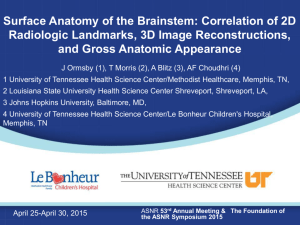A collection of Mnemonics to increase Memories and Learning in
advertisement
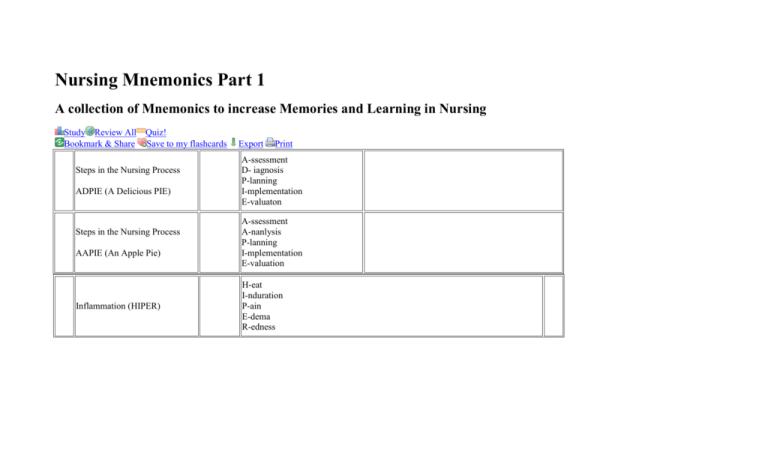
Nursing Mnemonics Part 1 A collection of Mnemonics to increase Memories and Learning in Nursing Study Review All Bookmark & Share Quiz! Save to my flashcards Steps in the Nursing Process ADPIE (A Delicious PIE) Steps in the Nursing Process AAPIE (An Apple Pie) Inflammation (HIPER) Export Print A-ssessment D- iagnosis P-lanning I-mplementation E-valuaton A-ssessment A-nanlysis P-lanning I-mplementation E-valuation H-eat I-nduration P-ain E-dema R-edness R-espiratory O-pposite M-etabolic E-qual Acid-Base (ROME) CANCER'S Early Warning Signs CAUTION UP CANCER Interventions C-hange in bowel or bladder A- lesion that does not heal U-nusual bleeding or discharge T-hickening or lump in breast or elsewhere I-ndigestion or difficulty swallowing O-bvious changes in wart or mole N-agging cough or persisten hoarseness U-nexplained weight loss P-ernicious Anemia C-omfort A-ltered Body Image N-utrition C-hemotherapy E-valuate response to meds R-espite for caretakers Hypoglycemia (TIRED) - an abnormal decrease of blood in the sugar T-achycardia I-rritability R-estless E-xcessive Hunger D-iaphoresis/ Depression Adrenal Gland Hormones (SSS) S-ugar (Glucocorticoids) S-alt (Mineralcorticoids) S-ex (Androgens) M-Morphine A-Aminophylline D- Digitalis Pulmonary Edema (MAD DOG) D-Diuretics (Lasix) O- Oxygen G- ases (Blood Gases ABG's) 5 P's of Circulatory Checks Hypertension Nursing Care (DIURETIC) P-Pain P-Paresthesia P-Paralysis P-Pulse P-Pallor (Paleness) D-aily Weight I- ntake and Output (I & O) U- rine Output R-esponse of BP E-lectrolytes T-ake Pulses I-schemic Episodes (TIA) C-omplications: 4C's 4 C's of Hypertension (Complications) Complications of Trauma Client (TRAUMATIC) Cyanotic Defects: 4 T's Cranial Nerve Mnemonic 01 C- Coronary Artery Disease C- Coronary Rheumatic Fever C- Congestive Heart Failure C- Cardio Vascular Accident T-issue Perfusion Problems R-espiratory Problems A-nxiety U-nstable Clotting Factors M-alnutrition A-ltered Body Image T-hromboembolism I-nfection C-oping Problems T- Tetralogy of Fallot T- Truncus Arteriosus T- Transportation of the Great Vessels T- Tricuspid Atresia O-Lympic (Olfactory) O-Pium (Optic) O-Ccupies (Oculomotor) T-ROubled (Trochlear) T-RIathletes (Trigeminal) A-fter (Abducens) F-inishing (Facial) V-Egas (Vestibulocochlear) G-ambling (Glossopharyngeal) V-Acations (Vagus) S-till (Spinal Accessory) H-igh (Hypoglossal) Cranial Nerve Mnemonic 02 Cranial Nerve Mnemonic 03 O- Oh O- Oh O- Oh T- To T- Touch A- And F - Feel A G - irl's V - agina S - So H- Heavenly O- On O -Old O- Obando T- Tower T- Top AF- Filipino A - Army G - Guards V - Villages A - And H - Huts Cranial Nerve Mnemonics (Sensory, Motor or Both) Cranial Nerve Mnemonics 02 (Sensory, Motor or Both) S - Some S - Says M- Marilyn M- Monroe B - But M- My B- Brother S- Says B- Bridget B - Bardot M- Mmm M- Mmm S- Some S- Say M - Marry M- Money B- But M- My B - Brother S- Says B- Bad B- Business M - Marry M - Money Nursing Care for Sprains and Strains (RICE) Care of Client in Traction (TRACTION) OB Non-Stress Test (NNN) 3 negatives in a row to interpret results of Non-Stress Test R- Rest I - Ice C - Compression E- Elevation T- Temperature (Extremity, Infection) R - Ropes hang freely A - Alignment C - Circulation Check (5 P's) T- Type & Location of fracture I - Increase fluide intake O - Overhead trapeze N - No weights on bed or floor N - Non-reactive N - Non- Stress is N - Not good Severe Pre-Eclampsia (HELLP) Assessment Tests for Fetal Well-Being (ALONE) H- emolysis E- levated L- iver function tests L- ow P- latelet count A- Amniocentesis L- L/S Ratio O - Oxytocin Test N - Non-Stress Test E - Estriol Level Evalution of Episiotomy Healing (REEDA) R- Redness E- Edema E - Ecchymosis D - Discharge, Drainage A - Approximation Evalution of Episiotomy Healing (REEDA) R- Redness E- Edema E - Ecchymosis D - Discharge, Drainage A - Approximation Post-Partum Assessment (BUBBLE) B-reasts U-terus B-owels B-ladder L-ochia E-pisiotomy/lateration/C-section incision Tracheal Esophageal Fistula (3 C's) Cleft Lip - Post Op Care (CLEFT LIP) C- Choking C- Coughing C - Cyanosis C-hoking L-ie on back E-valuate Airway F-eed Slowly T-eaching L-arger nipple opening I-ncidence incerase in males P-revent crust formation and aspiration ADLs (Activity of Daily Living) BATTED IADLS (Instrumental Activities of Daily Living) SCUM B-athing A-mbulation T-oileting T-ransfers E-ating D-ressing S-hopping C-ooking and Cleaning U-sing telephone or transportaiton M-anaging money and medications Bleeding Precautions (RANDI) Canes and Walkers (COAL) Canes and Walkers (WWAL) Wandering Wilma's Always Late Common Causes of Transient Incontinence (DIAPPERS) R- Razor Electric/ Blades A- Aspirin N- No needles (esp. in small gauge) D- Do decrease in needle sticks) I - Injury (Protect from) C- Cane O- Opposite A- Affected L- Leg W- Walker W- With A- Affected L - Leg D-elirium I-nfection A-trophic Urethra P-harmaceuticals P-sychologic E-xcess Urine Output R-estricted Mobility S-tool Impaction Promotion of Normal Elimination (POOPER SCOOP) P-osition O-utput O-ffer Fluids P-rivacy E-xercise R-eport Results S-ize (Amount) C-onsistency O-ccult Blood O-dor P-eristalsis Emergency Trauma Assessment (ABCDEFGHI) Trauma Surgery (AMPLE) after initial assessment A-irway B-reathing C-irculation D-isability E-xamine F-ahrenheit G-et Vitals H-ead to Toe Assessment I-ntervention A-llergies M-edications P-ast Medical History L-ast Meal E-vents Surrounding Injury Trauma Surgery (AMPLE) after initial assessment 6 P's of Dyspnea A-llergies M-edications P-ast Medical History L-ast Meal E-vents Surrounding Injury P- Pulmonary Bronchial Constriction P- Possible Foreign Body P- Pulmonary Embolus P- Pneumothorax P- Pump Failure P- Pneumonia Lidocaine Toxicity (SAMS) S-lurred Speech A-ltered Central Nervous System M-uscle Twitching S-eizures Lidocaine Toxicity (SAMS) S-lurred Speech A-ltered Central Nervous System M-uscle Twitching S-eizures TDCI (These Drugs Can Interact) T - Theophyline D - Dilantin C - Coumadin I - losone (Erythromycin) Serious Complications of Oral Birth Control Pills (ACHES) Emergency Drugs to LEAN on Drugs for Bradycardia & low BP (IDEA) Cholinergic Crisis (SLUD) Depression Assessment (SIG) A- Abdominal Pain C - Chest Pain H - Headache E - Eye Problems S - Severe Leg Pain L- Lidocaine E - Epinephrine A- Atropine Sulfate N - Narcan I - Isoproterenol D - Dopamine E - Epinephrine A - Atropine Sulfate S-alivation L-acrimation U-rination D-efecation S-leep Disturbances I-nterest Decreased G-uilty Feelings Energy Decreased (CAPS) 5 A's to Alzheimer Diagnosis C-oncentration decreased A-ppetite P-sychomotor function decreased S-uicidal Ideations A-mnesia A-nomia A-praxia A-gnosia A-phasia D- Distractibility I - Indiscretion G - Grandiosity Major Symptoms of a Manic Attack (DIG FAST) 3 P's of Blindness F- Flight of Ideas A- Activity Increase S- Sleep Deficit T - Talkative P- Preventable P- Painless P- Permanent Symptoms of Leukemia (ANT) Exercise Guide for Diabetic Fitness (FIT) A- Anemia N- Neutropenia T- Thrombocytopenia F - Frequency (3x per week) I - Intensity (60-80% of Maximal Heart Rate) T- Time (Aerobic Activity) Early Hypoxia: R-estlessness A-nxiety T-achycardia/ Tachypnea Symptoms of Hypoxia (RAT BED) Late Hypoxia: B-radycardia E-xtreme Restlessness D-yspnea Symptoms of Hypoxia (in Pediatrics) - FINES F-eeding difficulty I-nspiratory Stridor N-ares Flares E-xpiratory Grunting S-ternal Retractions Management of ASTHMA A-drenergics (Albuterol) S-teroids T-heophylline H-ydration (IV) M-ask (Oxygen) A-ntibiotics A-irway Closed I-ncreased Pulse R-estlessness Epiglottitis (AIR RAID) R-etractions A-nxiety Increased I-nspiratory Stridor D-rooling Blood Flow Through the Cardiac Valves (Tissue Paper My Assets) Immediate Treatment of a Myocardial Infarction Client (MONA) T-ricuspid P-ulmonic M-itrial A-ortic M- Morphine O- Oxygen N- Nitroglycerine A- ASA Treating CHF (UNLOAD FAST) U-pright Position N-itrates (in low dose) L-asix O-xygen A-minophylline D-igoxin F-luids (decrease) A-fterload (decrease) S-odium restriction T-est (Dig level, ABGs, K level) Make sure they don't have problems with: DEMENTIA Osteoporosis Risk Factors (ACCESS) D-rug and alcohol E-yes and ears M-etabolic and endocrine disorders E-motional disorders N-eurologic disorders T-umors and trauma I-nfection A-rteriovascular disease A-lcohol Use C-orticosteroid Use C-alcium low E-strogen low S-moking S-edentary lifestyle/s ACCESS leads to OSTEOPOROSIS Who needs dialysis? (Check the vowels: AEIOU) Prostate Problems are no... FUN BRAT Diet (for severe dehydration) Gluten Free Diet (ROW) A- Acid-Base Problems E- Electrolyte Problems I- Intoxications O- Overload of fluids U - Uremic Symptoms F- Frequency U- Urgency N- Nocturia B- Banana R- Rice A- Apple T- Toasted Bread R- Rye O- Oats W- Wheat Assess Changes in Senile Dementia (JAMCO) 3 P's of Diabetes Mellitus - Type 1 Signs & Symptoms Right-Sided Heart Failure (HEAD) Left-Sided Heart Failure (CHOP) Hyperkalemia Management (KIND) J- Judgment A- Affect M- Memory C- Cognition O- Orientation P- Polyuria (excessive urination) P- Polydypsia (excessive thirst) P- Polyphagia (excessive hunger) H- Hepatomegaly E- Edema (Bipedal) A- Ascites D- Distended Neck Vein C- Cough H- Hemoptysis O- Orthopnea P- Pulmonary Congestion (crackles/ rales) K- Kayexalate (orally/ enema) I- Insulin N- Na HCO3 D- Diuretics (Furosemide & Thiazides) Management of Myocardial Infarction (MONATAS) Electrolytes - PISO Eating Disorder: ANOREXIA Eating Disorder: BULIMIA M- Morphine O- Oxygen N- Nitrates (Nitroglycerin) A- Aspirin (ASA) T- Thormbolytics A- Anti-Coagulants S- Stool Softeners P- Potassium I- Inside S- Sodium O- Outside A-menorrhea delayed N-o organic factors accounts for weight loss O-bviously thin but feels FAT R-efusal to maintain normal body weight E-pigastric discomfort is common X-symptoms (peculiar symptoms) I-ntense fears of gaining weight A-lways thinking of foods B-inge eating U-nder strict dieting L-acks control over-eating I-nduced vomiting M-inimum of to binge eating episodes I-ncrease/Persistent concern of body size/shape A-buse of diuretics & laxatives Findings of a Bulimia client: WASHED W-eight loss of 15% of original body weight A-menorrhea S-ocial withdrawal H-istory of high activity & achievement E-lectrolyte Imbalance D-epression/ Distorted Body Image Outcome of Alcoholism: BAD 5 D's of Behavioral Problems of Alcoholism Situations requiring Crisis Situation: RAPE Warning Signs of a Child Abuse/ Neglect: CHILD ABUSE B- Brain Damage A- Alcoholic Hallucinosis D- Death D- Denial D- Dependency D- Demanding D- Destructive D- Domineering R- Ruthless A- Abusive P- Personal E- Experience C-hild's excessive knowledge on sex & abusive words H-air growth in various lengths I-nconsistent stories from the child & parent/s L-ow self-esteem D-epression A-pathy, no emotion B-ruised U-nusual injuries S-erious injuries E-vidence of old injuries not reported
